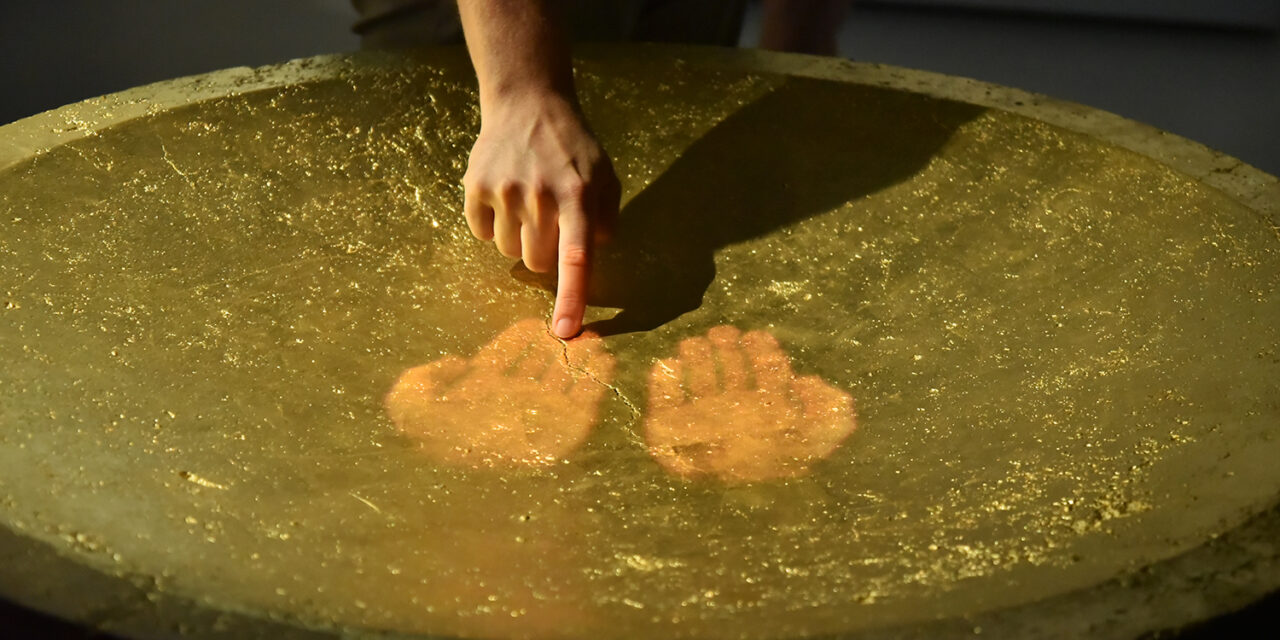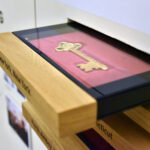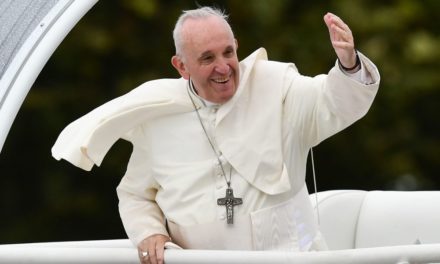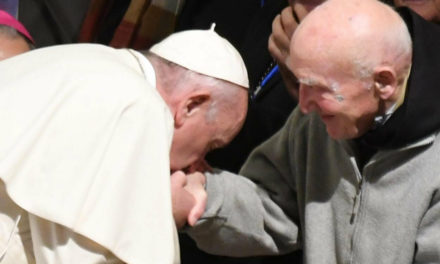Do you know what Cardinal Mindszenty was originally called? How is the monk who nursed him on his deathbed still alive? If you are interested in interesting things like this, follow the exhibition about the life of the prince-primate with us as part of an extraordinary guided tour. We visited the Mindszentyneum in Zalaegerszeg, which was handed over at the end of last year. With a photo gallery.
Every time I visit the house, I ask the workers here if any of the stairwells have moved yet - says Gergely Kovács, staff member of the Mindszenty Foundation, vice postulator of Cardinal Mindszenty's beatification process, referring to the special architecture that characterizes the building. The staircase - somewhat abstractly, of course - resembles the moving staircases at Hogwarts in the Harry Potter films. The postulator also predicts that at the end of our walk we can find a spell from the Harry Potter novels.
At the beginning of the special guided tour, Gergely Kovács mentions that the plans for the house and the exhibition took seven years to prepare. The building had to be redesigned due to an archaeological excavation, as four of the brick kilns of the former Zalaegerszeg castle were found during the preliminary research. Originally, the building was not intended to have front windows, but at the request of the city, larger and smaller windows were planned. In the huge hall, next to the grandiose staircase, there is a cash register and a cafe, near them, neon letters form a word on the ceiling, which, if read together, can reveal a beautiful thought of Cardinal Mindeszenty.

Photo: Tamás Császár
In several places in the building, the logo of the institution is echoed, consisting of a large letter M and a cross, the latter of which is an isosceles cross. The cross refers to martyrdom, and also to the fact that, traditionally, chief pastors sign their letters and documents by drawing a cross in front of their name. In the logo, it appears in gold because it refers to the creed. As we walk up to the floor where the exhibition begins, we admire how the slats covering the facade of the building are echoed in the interior spaces as well. The slats refer to the cardinal's captivity, and, supplemented by the intersecting lines, to Christianity. Arriving upstairs, the feeling of spaciousness and the charm of the spaces continue to affect us. And it all escalates later!
"I Brought Love Here"
Mindszenty had a reputation as a strict man, according to legend, when he was still a young priest, the faithful whispered among themselves: "laughing goes to the attic". Gergely Kovács begins the unique exhibition management, but his personality, he adds, gradually developed in the display of emotions or the exercise of love. When XII. Pope Piusz chose him as a bishop and asked him to be more fatherly, which he took seriously (all this was also very important from the point of view of the development of sanctity of life). That's why his famous phrase: "I brought love here" was put on the wall in front of the entrance to the first room. This idea appears in many of his speeches, in different variations. When he visited the country after the Second World War, he said at one of the stops, for example: "If there were people here who would not be happy about my coming, I brought love to them too."
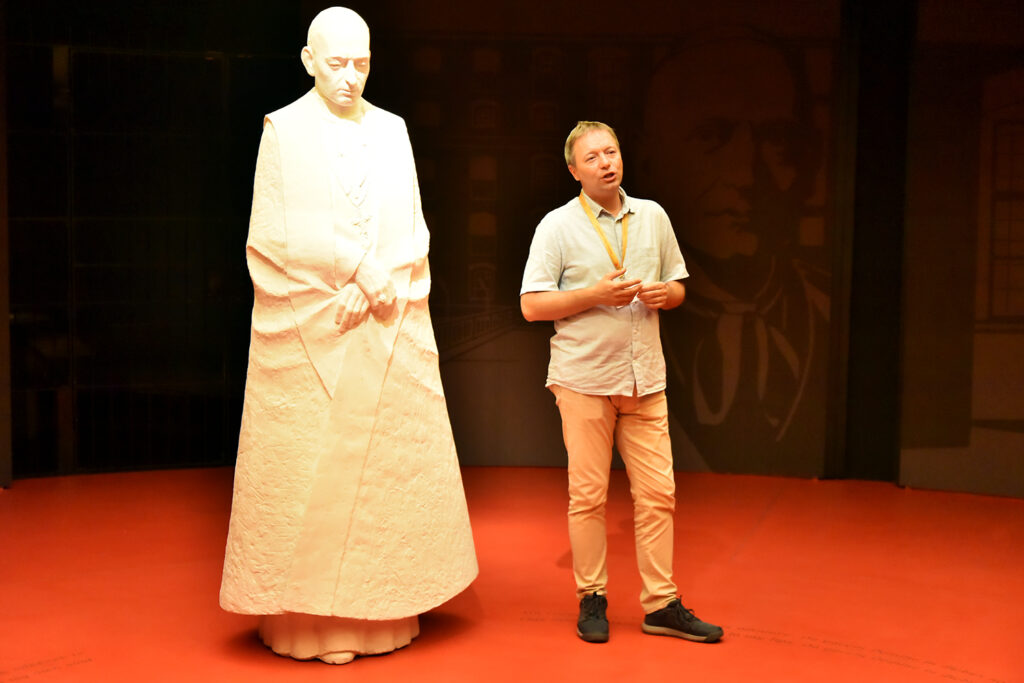
Photo: Tamás Császár
Entering the first room of the exhibition, you can hear the melody of the litany of All Saints from a folk collection, from the area around the native village of Csehimindszent, or Cardinal Mindszenty. Later, a litany from Loretto is heard, which also comes from a collection in Chehimindszent, from the 1960s, its keeper may have known little József Pehm. Because that was the original surname of the cardinal. According to Gergely Kovács, Pehm probably comes from the word Böhm, that is, on the paternal side, the family is of German-Czech origin. The later cardinal changes his name to Hungarian in 1942, in order to protest against the Nazi and Arrow ideas spreading in Hungary.
Gergely Kovács says that the dreamers of the exhibition decided to emphasize the name he chose because during communism, the prince-primate was often referred to as the reactionary Mindeszenty, the fascist Mindszenty. Fortunately, this attitude has disappeared, nowadays when we say the name of the cardinal, we only think of him and no one else, even in the case of Pázmány (Péter), Deák (Ferenc) or Kossuth (Lajos).
You can see Borbála Kovács, the prince's mother, which is interesting in addition to the family bond, because Mindszenty also had difficulties in the mother-son relationship. His mother was a tough, purposeful woman who, together with her husband, expected a lot from their only son. It meant a lot to Mindszenty when he managed to earn his mother's recognition, but it helped him to stand his ground even in difficult historical circumstances and endure the harshness of life.
By the way, the room can be divided into two clearly distinguishable parts: one is the part related to personal, human, family, profession, sanctity of life, which is located on a white wall surface, while the historical background can be viewed on a dark surface. At the front of the room, Mindszenty's years as an ultra-Catholic abbot-parish, city and county representative, and editor-in-chief of Zalamegye Ujság in Zalaegerszeg are brought to life.
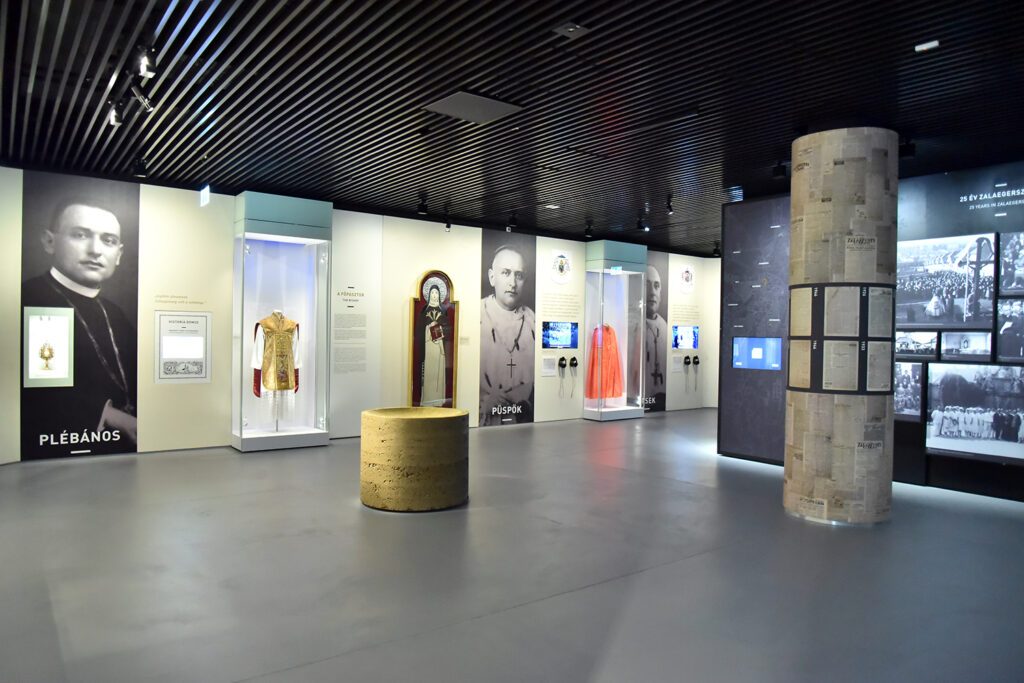
Photo: Tamás Császár
A baptismal font in the middle of the room attracts the eye. It is interesting that the installation was built from soil from the garden of the cardinal's parents' house. The earth was compacted using a technology similar to the production of clay bricks, only more modern. It weighs one ton. The pool of the well is painted gold, in the middle of which a projector projects two palms from the ceiling. The two palms symbolize the blessing, sharing, loving, baptizing priest's palms, and remind us of when Father Mindszenty's hands were anointed with oil during his ordination as a priest in 1915.

all holy
The vestments made in the 19th century, which remained in the parish of Mária Magdolna, were also placed in this axis. Gergely Kovács reveals: when the exhibition was set up, they noticed that Mindszenty was wearing the same ornatus (ceremonial dress of Catholic priests - ed.) in the nearest photograph. In 1948, when he returned to Zalaegerszeg as prince-primate, he also donned the most ornate ornate of the local parish. In another display case, the most valuable Rococo objects of the Zalaegerszeg parish were placed: a statue of the resurrected Christ, goldsmith's objects, a canon table, and a store-bought monstancia, indicating Mindszenty's frugality.
Cardinal in episcopal robes
As we move forward in time, more and more interesting things are revealed to us. One such example is the photograph in which Mindszenty looks into the photographer's lens in simple everyday clothes, a Swiss hat and a mustache, which has a special reason. When he became bishop of Veszprém, he felt it was his responsibility to take action against the archers. Why? He strictly followed the teachings of the Catholic Church and the papal instructions. His former bishop, János Mikes, also very firmly guided Mindszenty on the Jewish question, who also represented these guidelines. Standing on this basis, he already wrote in the summer of 1944 and said publicly that killing someone without a judicial verdict is not national defense, but murder.
Later, with the chief pastors of Transdanubia on their side, they wrote a memorandum in which they called on the Arrow government to end its rampage and at least save Transdanubia from the horrors of war. He personally handed the note to the deputy prime minister, and two weeks later he was arrested by the archers together with the priests standing by him. The archers also did this because Mindszenty insisted in all his sermons, mass, and public appearances that the moral truth must be spoken even if it might be dangerous for him. He continued to work even in captivity, founding the parish of St. Margaret. The picture was taken when they had a fake passport made for him in order to escape so that the Arrowmen would not take him as a hostage with the retreating German troops. In the end, this did not happen, the Soviet troops arrived at the house of the Daughters of the Divine Redeemer in Sopron.
Evoking the flower carpets and the light filtering through the rose windows of the church, the lighting of the square is colorful, not by chance: opposite the interesting photo, you can see huge protocol photographs of Mindszenty as bishop of Veszprém, archbishop of Esztergom, and cardinal of Rome, which are complemented by archival images. They are special at the same time, because few similar recordings have survived from the 1940s. In the first, Prince Justinián Serédi can be seen entering the Esztergom basilica, and in the other film, Mindeszenty's seizure of the seat in Esztergom and then his introduction in Budapest can be followed.
Perhaps the most special recording is the surviving footage of his creation as a cardinal, the curiosity of which is that XII. Piusz created 32 cardinals at the same time, so the protagonist of the document is not the then youngest Mindszenty, but for a few moments the prince-primate also appears in the back row, Gergely Kovács shows. The Pope said to Mindszenty: "You will be the first to undertake the martyrdom marked with purple!"
On the protocol wall, the curators managed to reconstruct Mindszenty's entire coat of arms. It is interesting that the cardinal did not know the coat of arms of his family until his appointment in Esztergom, which is important because he received a lot of criticism from the communists for his alleged aristocracy. The family coat of arms was then researched by Miklós Esty, papal secular chamberlain. When he was ordained a bishop in 1944, he chose St. Margaret's as his flagship (he was canonized by Pope Pius XII in 1943). Below the coat of arms, you can see the image of the appointment decree (the complete Hungarian translation will also be included in the mobile phone application that is already being prepared).
The researchers were well aware of Mindszenty's cardinal-prince-primate coat of arms, but not whether he used an archbishop's coat of arms before his creation as cardinal. Until, at an exhibition in Esztergom, the coat of arms with 10-10 green tassels (nowadays 15 are used on one and the other side of the coat of arms - ed.) appeared.
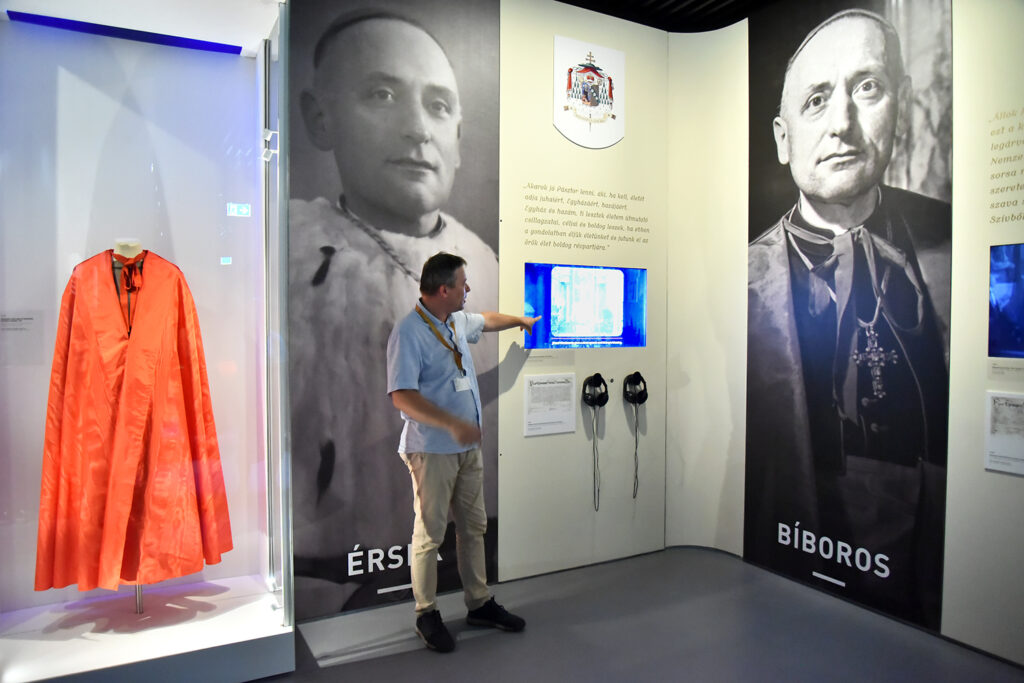
Photo: Tamás Császár
A cardinal's mantle, which has a special history, can also be seen in a glass cabinet. "The beautiful moiré (or moiré - the ed.) silk veil, the so-called Mindszenty never wore a Ferraiolo, for the simple reason that he didn't have one. Even as a bishop of Veszprém, he wore a purple mantle, he didn't have it made for him either, but he bought it from one of his predecessors. He also took this cloak to Esztergom, even after the ceremony of making him a cardinal, he was photographed in it. The reason for all this is that he did not want to have a moiré silk scarf made after the Second World War, instead he offered the price to the poor. As a sign of our respect, we subsequently made this cardinal's mantle in Rome," explains Gergely Kovács. He adds that moiré (a pattern similar to ripples in water or wood grain) inspired the building's designers when the slatted cladding was used to design the museum.
Black, red, gold - the period of martyrdom
On the next wall, you can read his country dedication prayer, which he recited in Székesfehérvár in 1946, and which was included in the foundation stone of the Hungarian Calvary of Fatima chapel of St. István.
But the square is getting narrower and darker, just as the air around the Prince Primate was dwindling: they kept spying on the Primate's palace in Esztergom, and a greengrocer opened in the square in front of it. Of course, the main profile was not the offer of vegetables: the ÁVO monitored the building and the movement of the cardinal.
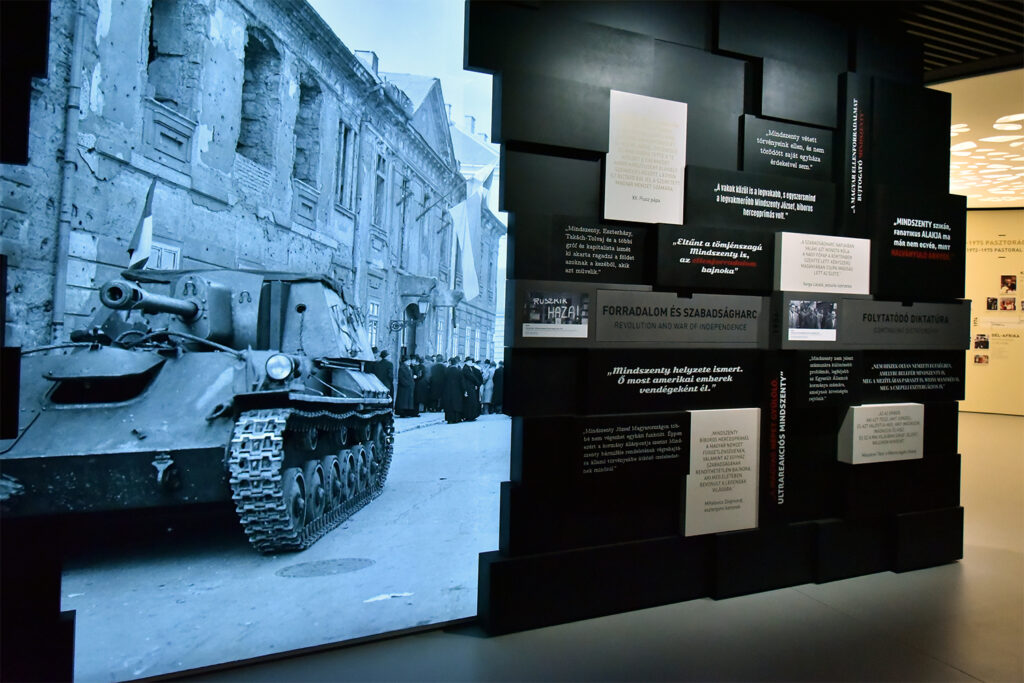
Photo: Tamás Császár
We reach the so-called defamation wall, on which some quotes from the press campaign launched against Mindszenty in 1946 can be read. The prince-primate testifies about this: "The severity of the times, the attacks and resolutions artificially incited against me, warn me that my hour is now approaching, and if my Master finds it worthy to take up his cross and follow Him, I will gladly do so. " Gergely Kovács states: when Mindszenty accepted the appointment as archbishop of Esztergom, he accepted martyrdom, and according to him this is not an exaggeration at all, since it is now known from the sources that the pope asked him in advance - through an emissary - whether he would accept the archbishopric of Esztergom and if life brings it, so does martyrdom. In his diary, Mindszenty expressed the fact that he was aware of his own shortcomings, exaggerations, fierce temper, and everything that could possibly limit him in the performance of a high position. Finally, he said yes to the invitation. "Nobody needs to be idealized in order to be able to respect and appreciate them in their place," states Gergely Kovács.
In any case, the communists tried to blacken his figure with a series of slanders, which unfortunately succeeded in front of half the country, although on the conservative side he developed an almost fanatical respect. The "reactionary, counter-revolutionary, capitalist, feudal people-skinning, treasonous" signification hidden behind the cardinal's mantle is particularly dishonest in light of the fact that - as we have seen - Mindszenty did not even have a cardinal's mantle...
Historians found out that he celebrated the Christmas Mass in 1948, and according to local tradition, he even celebrated mass on the morning before his arrest on December 26. At that time, Mindszenty's trust could only be directed to God, since he was almost completely alone in the coming weeks and months. This is recalled in the next room, when the moment of his carrying the cross came.

Photo: Tamás Császár
We arrive in a huge circular room dominated by red, black and gold, with the figure of the cardinal in the axis of the space, which is a plaster model of Tibor Rieger's Marian Hermitage and Fatima statue. The floor is red, symbolizing martyrdom, the wall is black, graphically immortalized when the cardinal is arrested (on the day of St. Stephen the Martyr), Mindszenty's way of the cross, and the words and thoughts that he had the right to have the last word in the communist show trial. "This morning this prayer came to my lips: Lord, give me peace these days! I asked for this peace for my church, whose love I brought here. I asked for this peace from the Hungarian state, to which I showed my obedience. And I ask for this peace for my soul as well".
We can listen to the audio of the trial with headphones using the devices mounted on the wall, while our eyes are focused on a cell, which evokes the cardinal's prison years. "No one knew that he was serving his sentence in the ÁVH prison on Conti Street in the middle of Budapest. For a long time it was believed that the prison was demolished, but in 2017 we found it. Soon, an original Conti street bunk will be placed in the room's cell," informs Gergely Kovács.
Otherwise, there is only a bed and a small table in the cell, on the latter a corporal (wafer tablecloth) with two wafers on it. With the latter, they symbolize bilocution (according to Catholics, the resurrected Christ and some saints are able to be in two places at the same time). Mindeszenty was not allowed to attend Mass in Conti Street for nine months, and what's more, he was not allowed to see his mother, except every six months. This period was extremely bitter for the prince-primate. Later it turned out that he was visited in prison by Father Pio, with whom he celebrated mass, for which the monk took the props necessary for the presentation of the mass. In an interview, Mindszenty later thanked Father Pio for his "both natural and supernatural help".
Four days off, twenty years of exclusion
We move to the era of the 1956 revolution, when the prince-primate was released from his prison; Mindszenty considered it very important that the Hungarian people freed him from captivity. The cockade stuck in the buttonhole is kept to this day, and will soon be presented at temporary exhibitions. During his four-day leave, he also gave a radio speech, a part of which can be listened to, and the thank you letter he wrote to the followers of Újpest for organizing a delegation to free him was exhibited. In it, he says: "Be faithful to your church, your Hungarian homeland, and your chief pastor who is a slave in your heart." The Primate's Palace in Buda was guarded by a Turul cannon, whose huge, illuminated photograph illuminates the space.
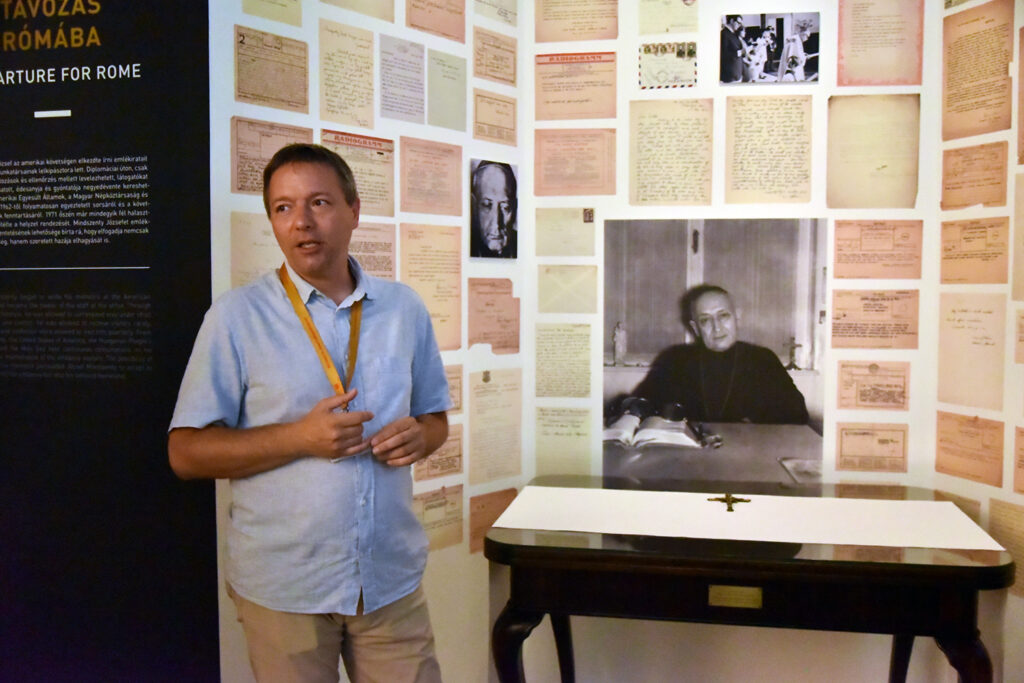
Photo: Tamás Császár
- on November 4, Mindszenty went to the American embassy, where he received asylum; you can read a selection from the period that followed, which messages the prince-primate received. There is also a small table with a strange story in front of the messages and the photograph of the cardinal. The Nazis made it, the Americans requisitioned it, and when Mindszenty came to the embassy and wanted to say mass, this table was made available to him. This piece of furniture became his altar table for 15 years. The table was later taken to his country by an Irish man, and when the system was changed, he was sent back to Hungary with a priest, saying that this table belonged here.
A semicircular tower room opens from here, commemorating the time when Mindszenty left the American embassy in Budapest in September 1971 and went to Rome, where VI. Pope Paul showered him with gifts as a sign of respect. In memory of this, the holy father's cardinal's coat, which he gave to the cardinal to "protect him against the cold weather in Vienna", was placed in a standing display case, knowing that Mindszenty was on his way to the imperial city.
The space is widened, where we can follow the emigration journeys of the Prince Primate over four years. Which is quite a lot, since he traveled 180,000 kilometers from Canada through Portugal to Australia. You can pull out several drawers from the wall, and in them you can discover keys to the city, which he received as a gift during his travels.
- On May 6, the saintly pastor passed away and was temporarily laid to rest in Máriacell. The merciful brother of the order who took care of the cardinal in the hospital in Vienna is still alive, we know from Gergely Kovács, as he says, they also met him recently in Vienna. St. II. Pope János Pál strongly wanted the cardinal's remains to be returned home, and later, when this happened, he indicated that he wanted to pray in front of the grave in Esztergom. A giant photograph bears witness to the scene. Harry Potter's "spell" mentioned at the beginning of the report can also be found here, as the cardinal's epitaph contains the phrase cruciatus - "he had to bear the cross of prison", reads one sentence of the epitaph in Latin.
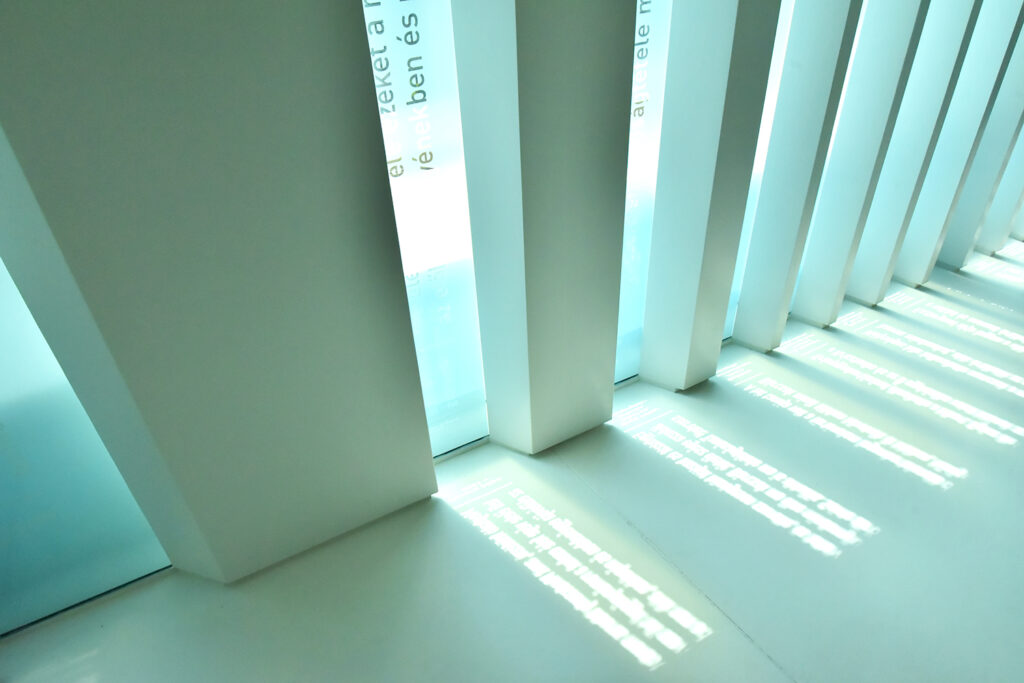
Photo: Tamás Császár
As if we were heading towards heaven, we reach the end of the exhibition in a white corridor bathed in light: the light filtering through the facade slats illuminates the papal and other words of appreciation written on the window glass, which are also visible on the floor. Opposite is the quasi-tomb of the saintly pastor in a modern chapel-like space.
Author and photos: Tamás Császár
- Photo: Tamás Császár
- Photo: Tamás Császár
- Photo: Tamás Császár
- Photo: Tamás Császár
- Photo: Tamás Császár

